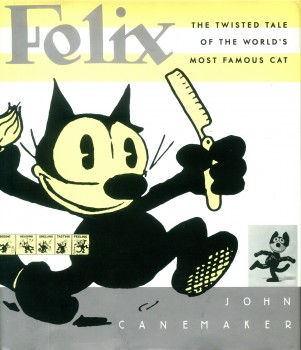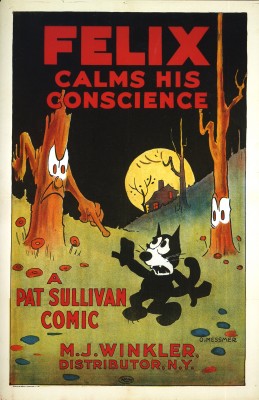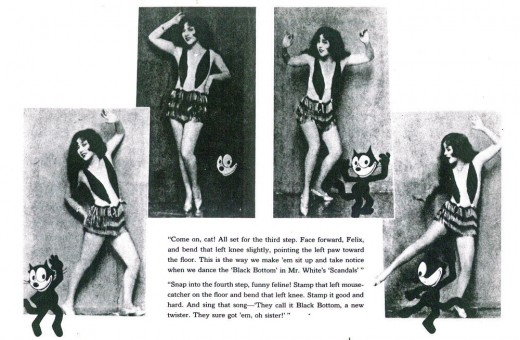Books &John Canemaker 13 Oct 2011 05:50 am
Canemaker’s Felix Book
- I’ve recently been rereading the classics. No, I don’t mean Madame Bovary or Great Expectations; I mean animation’s classic books. Since this blog came into being a mere 6 years ago, I haven’t had the chance to review many of these books, which predate this blog, and I thought it time to share my guilty pleasure (reading) with you. So, I’m about to start reviewing some older books. In a sense, I’ve already done this by commenting on some of the books I never got up to reading – such as Culhane’s Talking Animals and Other People. I’m also going to review some books I’ve been rereading.
 First up is Felix, The Twisted Tale of the World’s Most Famous Cat by John Canemaker. This was Canemaker’s second book, following his Winsor McCay, His Life & Art. This is the second time through this book for me (lately I’ve been into reading about the earliest days of animation’s history), and it’s every bit as entertaining and informative as my first read.
First up is Felix, The Twisted Tale of the World’s Most Famous Cat by John Canemaker. This was Canemaker’s second book, following his Winsor McCay, His Life & Art. This is the second time through this book for me (lately I’ve been into reading about the earliest days of animation’s history), and it’s every bit as entertaining and informative as my first read.
You get both a history of Pat Sullivan, the entrepreneur who made a success of Felix and Otto Messmer, the animator who actually developed and brought Felix to life. The two stories run concurrently, and it’s obvious that Sullivan’s life was more dramatic. His story is a potboiler.
At the very start of his studio, Sullivan was incarcerated for nine months after being convicted of raping a 14 year old girl. Then he watches Messmer develop Felix into a superstar, capable of competing with any live-action celebrity. Riches flowed into the studio most of which ended up in Sullivan’s pockets.

Still from “Sure Locked Homes”
At the end of his life, when Felix films were on a decline, Sullivan’s wife had committed suicide (although her falling out a window to her death may have been accidental), and Sullivan’s health began to quickly deteriorate. “Whether caused by grief over Marjorie’s death, years of alcoholic abuse, or the tertiary stage of syphilis that finally affects the brain, or a combination of all three, it was obvious that Pat Sullivan was losing his mind.”
This is a page turner of a story.
.
 Threaded through it all is the steady and less interesting read of the shy animator who worked tirelessly to create, develop and produce the first character to exhibit a screen personality. Otto Messmer was the synthesis of most animators: work hard during the day in a mostly internal job, then go home to the mundane, middle class existence in the suburbs. It doesn’t make for a great read, but it made for great films.
Threaded through it all is the steady and less interesting read of the shy animator who worked tirelessly to create, develop and produce the first character to exhibit a screen personality. Otto Messmer was the synthesis of most animators: work hard during the day in a mostly internal job, then go home to the mundane, middle class existence in the suburbs. It doesn’t make for a great read, but it made for great films.
Canemaker tells both well, and it does have its effect. The book moves quickly and enjoyably.
It’s also something of a scrapbook in that there are plenty of images of Felix to show you what a complicated character Messmer had created. These cartoons were certainly more for adults than children. There was plenty of alcohol in the films and strips that flowed from the studio. War was a subject that was treated seriously. World War I had acutely affected many of the animators as well as the audience, and these films were particularly successful in the series.
For ten years the films reached a zenith of riches, and it was difficult for other animated films to break through the inner circle that Felix had developed. Margaret Winkler and her husband, Charles Mintz, distributed the Felix films, and when Sullivan sought greater fees he threatened to quit. Winkler then developed the young Walt Disney to serve as a backup plan should she lose the Felix films. She eventually did. Her husband ultimately forced Disney out as well, and that’s when the historic happened.
 Disney created Mickey Mouse in his first sound film, Steamboat Willie. All of Sullivan’s tardy attempts to issue post-recorded versions of Felix with sound were useless, and Felix became a has been. Sullivan died within four years, and Otto Messmer quietly spent the rest of his life hiding behind the Felix the Cat comic strips. It’s a sad story that John Canemaker reveals, and he gives the full version in this attractive book.
Disney created Mickey Mouse in his first sound film, Steamboat Willie. All of Sullivan’s tardy attempts to issue post-recorded versions of Felix with sound were useless, and Felix became a has been. Sullivan died within four years, and Otto Messmer quietly spent the rest of his life hiding behind the Felix the Cat comic strips. It’s a sad story that John Canemaker reveals, and he gives the full version in this attractive book.
I remember way back when, I think it was 1975, that I accompanied John Canemaker on a trip to Otto Messmer’s house and got to meet the man. The afternoon was quite pleasant, and I sat as an observer witnessing a casual and enjoyable Q&A with Mr. Messmer. I don’t remember much about the interview, but I do remember it as sunny and quite agreeable. I also remember my first reading of this book and seeing how John had turned that interview into something meatier than I remembered witnessing. He certainly interviewed Messmer many more times for the book (and the valuable documentary Otto Messmer and Felix the Cat, that he made in 1977.) It was my first time to see the fruit turned into facts, and it was an eye-opening experience.
Today I see the very informative book, and I also see the stylistic prose John adapted in the writing. It’s obvious he was completely invested in the subject and period and people of this book, and you can’t ask for much more from such an historic account. If this book isn’t part of your collection, it should be. At least, borrow it from the public library and read it.
Here‘s a nice interview from1991 with John and ira Gallen.
The documentary, Otto Messmer and Felix the Cat can be found on the DVD John Canemaker, Marching to a Different Toon.



on 15 Oct 2011 at 5:39 pm 1.Devon said …
I recently borrowed the book from my school library. Easily one of the best animation-related books I have ever read.